A Trip to New Zealand
(or, Chronicle of a Dream)
For Family and Friends, I'm providing a commentary on my visit
to New Zealand, in the late winter of 2007. This is a trip that I've long
anticipated, and finally, came to be a reality. Clicking on items
of the menu below will allow you to jump through elements of the trip, including
the day to day impressions and photos of the journey as they were added as I moved
along. I hope you enjoy traveling with me!
MENU
Background
Always an interest of mine, the wonderful country of New
Zealand features some of the most spectacular scenery to be found, and is
noteworthy for its
geologic history and consequent faunal development. In
the annals of Continental Drift, today's New Zealand separated from
Gondwanaland and its
sibling plate, the present Australia, before mammals had made their way across
the Antarctic and Australian plates as they separated from today's South America.
Hence, New Zealand, uniquely among continental land masses today, lacked any form of
land mammal fauna (except for a couple of bat species) until latter day
introductions by humans. Aside from a few amphibian and reptilian
quadrupeds, the only early post-Cretaceous colonizers of this set of islands
were birds. Without mammalian predators, the early arriving birds evolved
an extraordinary number of flightless forms, including the living species of
Kiwis, and a spectacular assemblage of larger "Moas", all of which (the Moas)
are today extinct. The surviving endemic flying birds include a number of
unusual species, whose relationships with other birds of the world are not
clear.
New Zealand, like Australia, is also known for an unique, but depauperate,
freshwater fish fauna
(about 35 species) that features a number of catadromous species
(eels, geotriid lampreys, galaxiids, etc). The occupation of this unique
environment by humans, and their numerous introductions of plants, fish, and
mammals, has had enormous consequences for the endemic flora and fauna of New Zealand, and
those consequences continue today. Even after many extinctions of birds,
fish, reptiles, and plants, a large number of the surviving endemic species are
endangered or threatened.
New Zealand's human history was first explained to me in a college course
("The Peoples and Problems of the Pacific") taught by
Leopold
Pospisil at Yale,
about 1959. He argued for for a successive occupation of New Zealand by
three waves of "invaders". The first of these arrivals from the Indonesian
region are termed the "Moriori", and populated a New Zealand rich in the Moa
flightless bird fauna. Some of the Moas, such as the Giant Moa, were
ostrich-size birds, and these apparently were partially domesticated by the
Morioris, who seemed to live an agrarian and peaceful lifestyle.
The next wave of immigration, beginning perhaps about 500 to 800 AD, also
appears to have originated from today's Indonesia, and was constituted by
a more aggressive culture, the Maori people. The Maori dispersal did
not stop at New Zealand, but spread across the Pacific Islands, populating Fiji,
the Society Islands, and ultimately the Sandwich Islands (Hawaii).
It should be noted that a popular (in New Zealand) contemporary hypothesis is that
the Moriori dispersal did not reach New Zealand proper, but was confined to the
Chatham and other nearby islands to the south and east. This alternative idea has the Maori
people traveling across the Pacific to the Society and Sandwich Islands from
Indonesia, and only later "hooking back" to populate New Zealand.
In Pospisil's view, the outcome of the occupation of New Zealand by the Maoris was the
extermination of the earlier Moriori settlers, followed by the extermination of
the larger flightless land birds, particularly the Moas. That
extermination of the Moas was complete by early 1700s, the remains of these
birds are well
known today from subfossil specimens.
A vivid story told by Professor Pospisil in this course was one that relates
to one of my present interests--the whaling history of New Bedford.
According to him, about 1830 or so, a whaling ship stopped for water, wood, and
fresh food in the Chatham Islands. The Chatham Islands lie about 600
kilometers
southeast of New Zealand--and today are part of the nation of New Zealand. The
island apparently was populated, at that time, by peoples who were surviving
remnants of the earlier Moriori immigration that had escaped the notice of the Maori wave of immigration.
On board the whaling ship were several Maori crew members, signed on the
crew during an earlier visit to New Zealand. Recognizing the Chatham
Island Morioris as their ancestral enemies, these crew members waited for
the whaler to return to New Zealand, then deserted to alert their elders about
the presence of Morioris on the Chathams. A war party was gathered, and
the Maori tribesman sailed and paddled their open canoes the 600 kilometers and then
systematically slaughtered the Morioris. Whether
true or not (see
http://history-nz.org/moriori.html for a somewhat different historical
account), the tale has a certain pizazz to it!
Of greater certainty is the arrival of the third wave of immigration to New
Zealand, the Europeans (Pākehā
in Maori), who, led by Abel Tasman's discovery of New Zealand about 1642,
and James Cook's first visit there in 1759, populated the country, mainly after bitter fighting between French and English
colonists and the Maori tribes. The overt strife ended with a treaty about 1840 (see
http://history-nz.org/ ). The
resulting English subjugation of the country caused immense changes to the
bioscape. These involved reducing the native Maoris to second class
citizenship, introduction of domestic animals (sheep, cats,
dogs, cattle), game birds (pheasants, quail, ducks, partridge), game animals
(red deer, Himalayan Taur), fish (trout, salmon), vermin (rats, rabbits, mice, stoats,
Australian Possums) and many new plants and trees (conifers,
grains, grasses, etc). The native
forests were cut down, (replacing them with non-indigenous trees), thus
destroying the habitat for the native birds, and new predators were introduced that
many members of the endemic fauna (mainly birds and fish) were ill equipped to
handle. Thus the number of extinctions recorded in the last few hundred
years is large (almost 50 species of birds -
http://en.wikipedia.org/wiki/List_of_New_Zealand_birds ), and the number of
endemic species that are endangered or threatened remains high today.
In my reading about New Zealand, I've been attracted by the writings of
New Zealand scientists who study the sharks that are of my especial research
interests, as well as reading about the affinities of the New Zealand fauna (particularly the
sea birds) to that of the sub-Antarctic islands and mainland Antarctic about
which I've studied and written.
The allure of New Zealand to me, then, has always been great. This
year, having gained a windfall of sorts from my antique tool business, I am now
able to travel to New Zealand, and see this
wonderful land for myself. This web page is being written as a chronicle
of my trip.
Planning
Early November of 2006 began the first fairly serious planning for my New
Zealand odyssey. The first stop, of course, was Google, where the top hit
was the New Zealand office of tourism's website -
http://www.newzealand.com/travel/northamerica/ . There is a lot
of basic information here, including maps and descriptions of the various
regions of the country. New Zealand is comprised by two
main islands--North and South--along with some far flung smaller island groups,
including the Chatham and Auckland Islands.
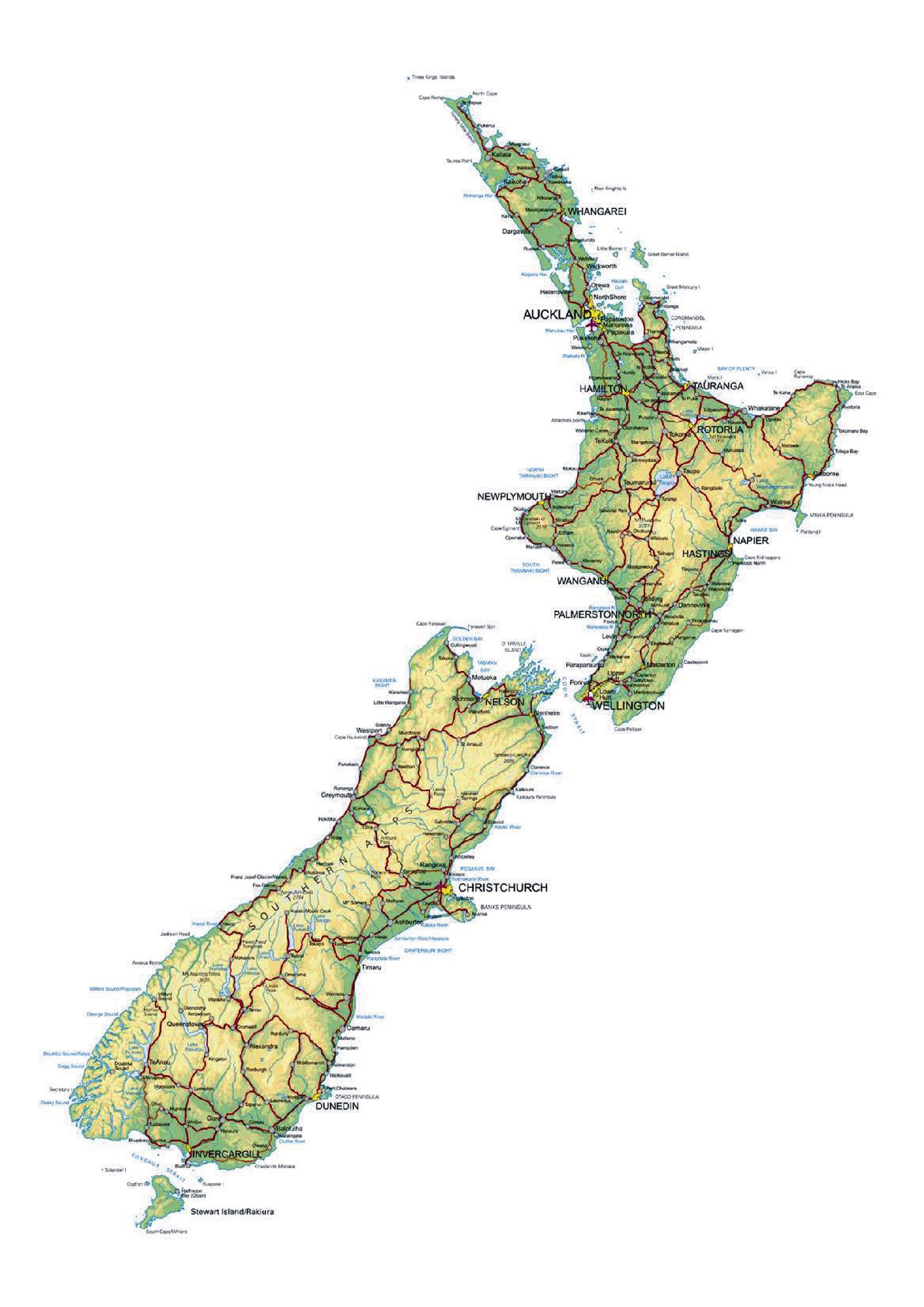 Altogether the country is
about the size of Colorado in terms of land area, and is host to about 4 million
inhabitants. It sits in the South Pacific Ocean, with the Tasman Sea to
its west. The North Island rubs against the 180th meridian, and in terms
of latitude it stretches from about 35 degrees South, to about below 45 degrees South.
New Zealand is astride the junction of two tectonic plates, and earthquakes and
volcanic activity are not uncommon. The North Island, in particular, is
host to geothermal regions with hot springs and geysers regular features.
The New Jersey-shaped South Island has been more orogenic and sports a
cordillera on its western side, with fairly broad outwash plains on the east.
The southwest corner (Southland) of the South Island is broken into a
spectacular set of fjords.
Altogether the country is
about the size of Colorado in terms of land area, and is host to about 4 million
inhabitants. It sits in the South Pacific Ocean, with the Tasman Sea to
its west. The North Island rubs against the 180th meridian, and in terms
of latitude it stretches from about 35 degrees South, to about below 45 degrees South.
New Zealand is astride the junction of two tectonic plates, and earthquakes and
volcanic activity are not uncommon. The North Island, in particular, is
host to geothermal regions with hot springs and geysers regular features.
The New Jersey-shaped South Island has been more orogenic and sports a
cordillera on its western side, with fairly broad outwash plains on the east.
The southwest corner (Southland) of the South Island is broken into a
spectacular set of fjords.
The climate of the North Island is more subtropical,
with wonderful beaches, island chains, more recent volcanism, and a South Pacific "feel" to it.
The South Island is more rugged, with lots of mountains and a rockier coast.
Its climate is colder and wetter than in the north, clearly more temperate in
character. The south also experiences more earthquake activity in the
present era.
In the North are the principal cities of Auckland (host to the
main international airport) and Wellington, the capital city. The South
island's major cities include Dunedin and Christchurch (the largest in the
South), both of which are on the
eastern side and lie at the bases of peninsulas that jut into the Pacific where
they serve as hosts to a lot of interesting birds, fishes, and marine mammals.
The most southern tip of the South Island leads to Stewart Island (New
Zealand's "third island"), where much of the original New Zealand flora and
fauna persist, and with a hint of the sub-Antarctic fauna to the south.
My appeal is more to the South than the North. Its more rugged
topography, colder climate, and array of sea birds, fish, and marine mammals
calls to me. So I quickly decided that, if I had only 3 weeks to spend in
New Zealand, I'd prefer to spend them in the south. As for organized tours
(there are plenty), my feelings were that I didn't want to be held "captive" to
a plan, and would prefer to see some places the tours don't touch, as well as
have the freedom to alter my plans if the unexpected arose. The possibility
of renting a car, and "self-drive" through the country really appealed.
The downside of this option would be the daily challenge of finding
accommodation as I moved through the country. Twenty years ago that would
have been an option, but now the daily anxiety of "where will I bunk" tomorrow
is not welcome. So, using the New Zealand tourism website as a base, I
contacted a number of travel agencies that specialized in setting up trips to
New Zealand. Most that were contacted seemed eager to work with me in
establishing a route, and suggesting things to see along the way. My list
of places to visit had some definite "must sees". These included Westport,
the glacier region of Franz Josef and Haast, Stewart Island at the far southern
tip of the South Island, whale watching at Kaikoura, Dunedin and the Otago
Peninsula to see breeding albatrosses, and Christchurch.
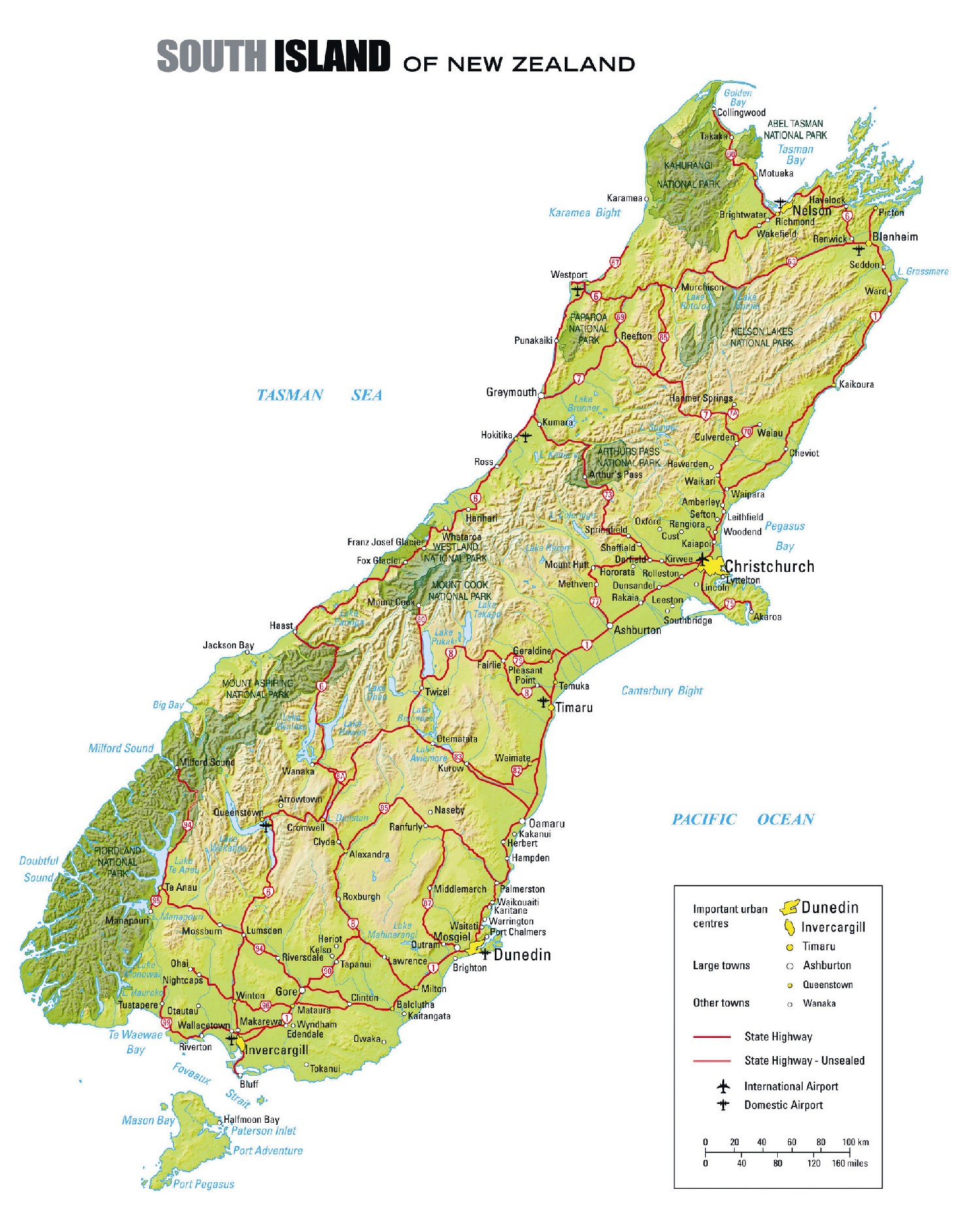
In early November, after several emails back and forth with travel agents,
it quickly became clear that one of the most sympathetic, knowledgeable, and
responsive people was Anne Wellnitz
(awellnitz@downunderendeavours.com) of Down Under Endeavours (http://www.downunderendeavours.com/map_nz.php
), an Australian travel agency with American offices in Chicago.
Deciding to go with Anne as a planning guide and facilitator, it wasn't long
(by Thanksgiving) that my trip was pretty well roughed out. And in early
December the trip was squared away, with plane, rental car, hotel reservations,
and some special tours booked. Also there was plenty of free time to
explore on my own, and except for six days of accommodations packaged with
meals, to eat where and when I liked. Anne suggested things that really
appealed to me (Stewart Island Lodge with some outstanding tours, Lake Moeraki
wilderness lodge, overnight cruise to Doubtful Sound in the fjord region, and a
tour of the Otago Peninsula).
What was left to me was booking flights to Los Angeles and return, and
filling my otherwise empty days days in New Zealand. No Problem. The
final trip looks like this.
Feb 20 - The Trip Out
February 2007
Tues
20 Providence to Newark, NJ.
Continental AL # 2936
8:30 AM to 9:40 AM
Tues
20 Newark, NJ to Los Angeles Calif.
Cont. AL # 17
1:20 PM to 4:29 PM
Tues-Thur. 20-22 Los Angeles to Auckland,
New Zealand Qantas QF 26
8:30 PM to 6:00 AM
Thursday 22 Arrive Auckland
The trip out was a long one, but with no real disasters. Barb and
Melissa drove me to Providence Airport, and the plane to Newark was on time.
Coming into Newark, it was apparent the the New Jersey Turnpike was not the
place to be--it was a parking lot of huge trucks. Glad to have flown!
The Continental flight to Los Angeles was packed full, and was delayed
almost an hour at takeoff. The pilot made up the time, however, and it
landed just about right on time. There was no trouble getting to the
international terminal and finding the Qantas counter. Not much delay
here, either, although again the plane was full to the brim and a little late
getting underway. The 12 hour flight was a little rough, but the folks
sitting around our section were pleasant. I even got a few hours of sleep.
Qantas does a good job. Lots of freebees, everything for your comfort, and
doesn't charge for drinks. Again, we landed right on time in a somewhat
warm 75F Auckland, with the humidity on the high side. The GPS unit tells
me that the total mileage for the trip, straight line from our front door to the
airport is 8976.9 miles. It took 30 hours of travel--still a pretty good
average speed!
Return to MENU
Day by Day
Day 1 - 2: Feb 22 & 23, 2007
06:00
Flight QF26 Arrives
Meet 'n
greet by Down Under Endeavours Representative. Document exchange
and private transfer to the hotel
15:00 Room check in
( early check in requested but
not guaranteed )
Accommodation: Scenic Circle Airedale Hotel
380 Queen Street
Auckland
Telephone : 64 9 374
1741
Fax : 64 9
374 1740
2 nights : Room Only
Counting the time zones, and ground connections the actual trip time works out to something
more than 28 hours--yet I land in Auckland two days after
taking off from Providence. That extra day (Feb 21, 2007) is lost upon
crossing the international date line (the 180th meridian) shortly before landing
in New Zealand--never to be recovered.
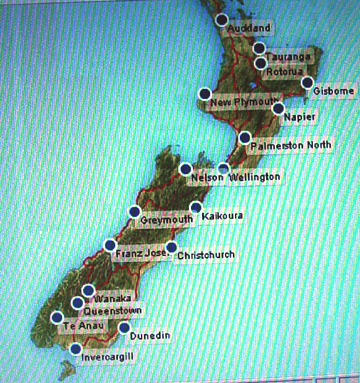 Auckland, New Zealand's largest city is reputed to be a vibrant, interesting
place (http://www.aucklandnz.com/ ).
Its urban region includes 1.2 million people (more than 25% of the total
population of New Zealand) spread out over more than 400 square miles. The
main city area is located on an isthmus with close access to water on both
sides. The opportunity for water sports is great, and Auckland is
sometimes called, "The City of Sails." (http://en.wikipedia.org/wiki/Auckland).
Auckland, New Zealand's largest city is reputed to be a vibrant, interesting
place (http://www.aucklandnz.com/ ).
Its urban region includes 1.2 million people (more than 25% of the total
population of New Zealand) spread out over more than 400 square miles. The
main city area is located on an isthmus with close access to water on both
sides. The opportunity for water sports is great, and Auckland is
sometimes called, "The City of Sails." (http://en.wikipedia.org/wiki/Auckland).
On my second day, I've decided to grasp the opportunity to explore the
island-rich Hauraki Gulf, and have
booked a trip
to the island of
Tiritiri
Matangi, which is maintained by the New Zealand Dept. of Conservation as a
predator-free oasis of endemic plant and animal species. Here numbers of
New Zealand's rare and endangered bird and reptilian species are maintained.
Noteworthy is the large (3 kg) flightless bird, the
Takahe, which is an
extremely rare creature, as well as introduced and relict
Tuatara (Sphenodon
punctatus), a rhyncocephalian reptile found nowhere else in the world.
The trip takes 1 1/2 hours from Auckland, and will surely provide a great
introduction to the bird life and islands of this volcanically rich area.
Here is a report of day 1
Auckland (36o 51.164' S; 174o 45.895' E;
Elevation = 42')
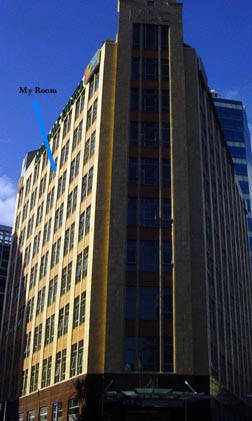
 My
first impressions of Auckland were that it has a pretty vibrant center city
section. The streets are flooded with people, cars and buses. Lots
of pretty young girls, a just about everyone, sans the tourists, are well
dressed. My hotel is right on the main drag (Queen St), a few blocks above the
harbor. Right across the street is the old City Hall, that doubles as a
concert hall for the Auckland Chorus, among other performing groups.
My
first impressions of Auckland were that it has a pretty vibrant center city
section. The streets are flooded with people, cars and buses. Lots
of pretty young girls, a just about everyone, sans the tourists, are well
dressed. My hotel is right on the main drag (Queen St), a few blocks above the
harbor. Right across the street is the old City Hall, that doubles as a
concert hall for the Auckland Chorus, among other performing groups.
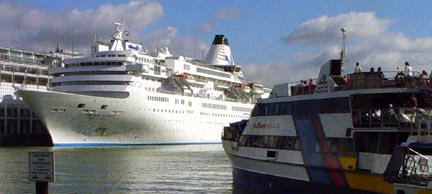

The folks in Auckland even staged a demonstration of striking
union workers for my pleasure!
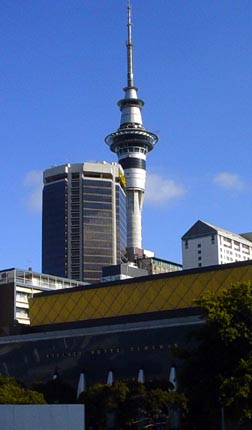 The signature Sky
Tower of the town is just two or three blocks away. The waterfront is
active with local cruise boats, ocean-going cruise liners, and lots of people
milling around. There are many restaurants, here, and I had a nice lunch
in a fairly elegant Japanese one, with some sashimi and grilled eel over rice.
It was good.
The signature Sky
Tower of the town is just two or three blocks away. The waterfront is
active with local cruise boats, ocean-going cruise liners, and lots of people
milling around. There are many restaurants, here, and I had a nice lunch
in a fairly elegant Japanese one, with some sashimi and grilled eel over rice.
It was good.
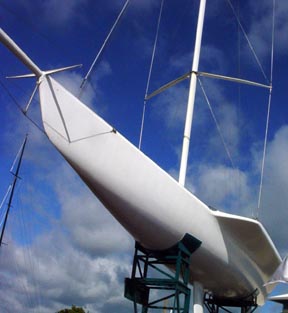
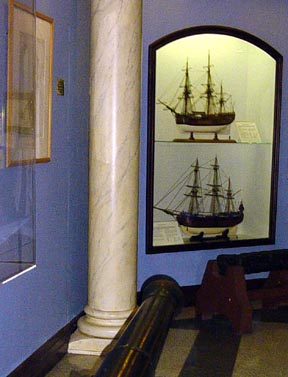 With
a little time to kill, I made a quick trip through the Auckland Maritime Museum.
It was interesting--especially the material and information about Maori war
canoes, Captain Cook's visits to New Zealand, and some of the information they
had about the whaling days. They had a very nice film of the actual
killing of a right whale from shore based boats, using exploding harpoons.
It was interesting.
With
a little time to kill, I made a quick trip through the Auckland Maritime Museum.
It was interesting--especially the material and information about Maori war
canoes, Captain Cook's visits to New Zealand, and some of the information they
had about the whaling days. They had a very nice film of the actual
killing of a right whale from shore based boats, using exploding harpoons.
It was interesting.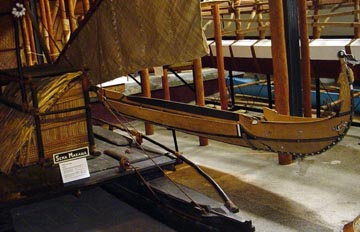
On my second day in Auckland I decided to take a trip across the Hauraki
Gulf to the island of Tiritiri Matangi, which is a predator-free island,
maintained by the Department of Conservation as a preserve for endangered New
Zealand endemic birds and lizards.
Day 3: Feb 24, 2007
Saturday 24 Auckland Nelson Flight
NZ8375T 0855/1015hrs
10:15
Flight NZ8375T arrives Nelson
Pick up rental car at the airport Budget Rent a Car
Self drive to
the hotel
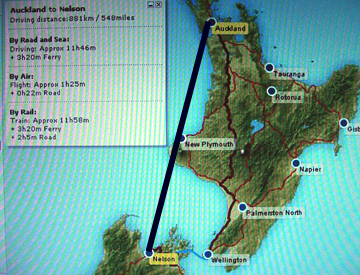 Accommodation: The Rutherford A Heritage Hotel
Accommodation: The Rutherford A Heritage Hotel
Trafalgar Square
Nelson
Telephone : 64 3 548
2299
Fax : 64 3
546 3003
The flight to Nelson should be a scenic one. The driving
distance from Auckland is about 550 miles, taking about 12 hours, plus a 3 1/2
hour ferry ride across the Cook Straits to the South Island. But, by plane
the travel time is only 1 1/2 hours. If the weather is nice there should
be some good views of the western coast of the North Island, as well as the Cook
Strait. After picking up my rental car, I'll find the hotel, and then nose
around Nelson.
Or, it might be a pleasant afternoon to drive out to the
Abel Tasman
National Park to walk and sight see. At any rate, I look forward to
exploring the Nelson waterfront and restaurants.
The trip from Auckland to Nelson was in a small turboprop
plane and lasted about 1 1/4 hours. After takeoff, the plane headed
Southeast, passing over flat farmland given to truck crops and hay, and then
approached the coastline of the Tasman Sea. This section had a rougher
topography just behind the shoreline, and appeared to be quite dune-like,
covered with brownish grass. The surf looked great for the folks with surf
boards.
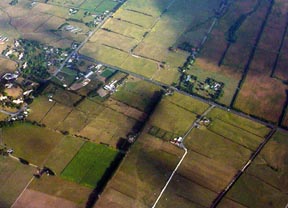
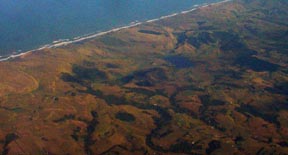
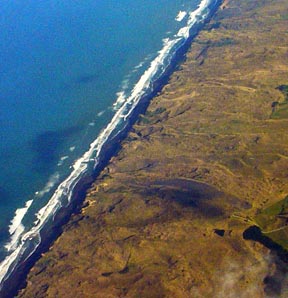
The plane's track then crossed the projecting Taranaki peninsula of the
southern part of the North Island, and flew over the dominant feature of Mt.
Taranaki, an extinct volcano that rises more than 2500 meters. As you can
see, it has a quite symmetrical cone, with a visible crater.
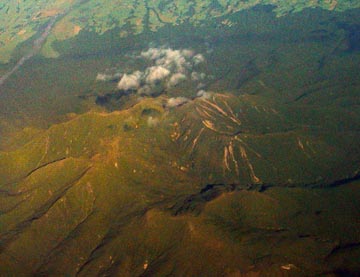
Leaving Mt. Taranaki behind the track moved out across South Taranaki Bight
of the Tasman Sea, heading for Nelson. The water here appeared extremely
rough, and I had the sense that there was a wind from the west really pushing
against a west-heading current.
As we approached
Nelson, it was possible to make out the outline of Farewell Spit, a hook-shaped
shallow sand bar that stretches east from Cape Farewell. This long sliver
of sand is a mecca for bird watchers, as it is populated in the New Zealand
summer by huge numbers of wading birds and shore birds that have migrated south
from the Arctic. It also is a regular site of whale strandings--particularly
Pilot Whales and Sperm Whales.
The landing at Nelson was smooth, and in a short while I had possession of
my rental car, and was pulling out of an airport that was much less busy than
Kennedy! The hills abutting the airport are clearly in management for
timber production, and are patchworks of clear-cut, juvenile, and mature timber
stands.

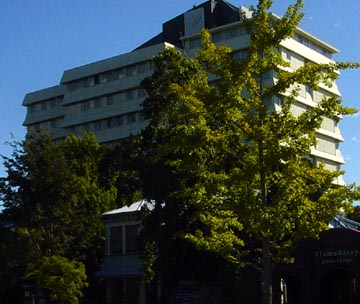 After
nursing the car along the "wrong" side of the road into the town of Nelson, I
found my hotel--The Rutherford--in the city center. It was easy to find,
as at about 9 stories high, it is clearly the tallest building in town.
After
nursing the car along the "wrong" side of the road into the town of Nelson, I
found my hotel--The Rutherford--in the city center. It was easy to find,
as at about 9 stories high, it is clearly the tallest building in town.
Just across the street from the hotel is a steep hill that is planted to
legions of flowers, and many specimens of large trees, including hoop pines,
cabbage palms, and a good sized California Redwood. The hill is
capped by a cathedral with a bell tower holding a chime.
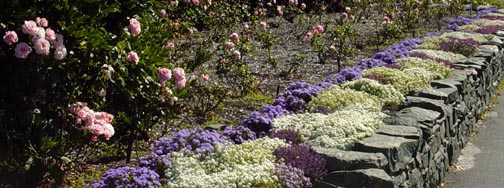
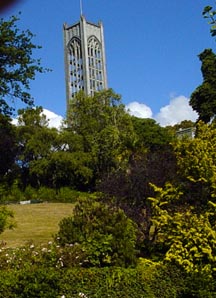
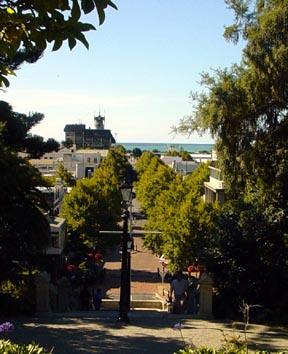
The view from the cathedral looks out over the town of Nelson to the Tasman
Bay. It is quite nice.
With plenty of time to look around, I drove east of the city to the base of
a remarkable formation known as "Boulder Bank." This bank of huge rounded
cobbles stretches for several miles, and encloses a large, very sheltered and
shallow bay, that was the reason the town of Nelson is located where it is.
The process of the formation of the boulder bank is not clear to me. It is
not a man-made structure, and its origins is discussed in some Maori legends.
The access to the bank is close to its eastern end, and the pictures below show
it from looking west to north to east.
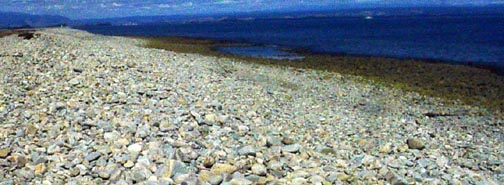
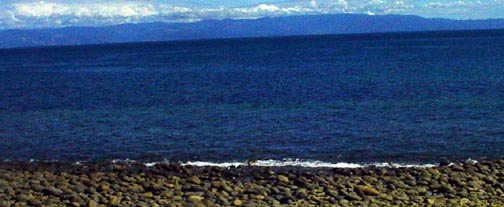

The distant hills in the center picture comprise the Abel
Tasman Park.
Back in Nelson, I visited an open air Saturday market, which
was quite festive, with lots of really nice vegetables and fruits, along with
some quality craft items, and many other things. I bought a bag of Biltong
(dried beef) for lunch, and had a nice chat with a gent selling old hand tools.
I almost bought a very nice Disston boxwood mortise gage, but decided it would
be foolish to lug it back halfway around the world! Finally, the day ended
with a trip to the local historical museum, which turned out to be very
informative and interesting about the farming, mining, and manufacturing history
of Nelson and the surrounding region.
After a good meal of New Zealand Green Lip Mussels, and some
fish and chips, I expect to get a good night's sleep before moving on to
Kaikoura in the morning.
Days 4 . Nelson to Kaikoura
Sunday
25 Nelson Kaikoura
Self drive to
Kaikoura
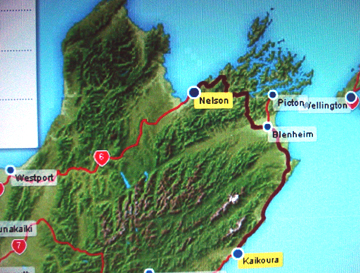 Accommodation: Kaikoura Gateway Motor Lodge
Accommodation: Kaikoura Gateway Motor Lodge
16 18 Churchill Street
Kaikoura
Telephone : 64 3 319
6070
Fax : 64 3
319 7080
The drive to Kaikoura from Nelson is about 170 miles, with an estimated drive
time of about 4 hours. The route goes through the Marlborough Sound area
and the town of Blenheim. This is the center of New Zealand's most famous
wine producing region. I'll stop to sample a bit at lunch time. The
rest of the trip south from Blenheim borders the South Pacific
along the eastern side of the South Island, with mountain ranges to the west.
It should be spectacular. Kaikoura is the site of New Zealand's most
famous land-based whaling venture in the mid 1800s, and today is known for its
whale watch trips that predictably encounter sperm whales. This is one of
the very few places in the world where sperm whales can be observed close to
shore (the Azore Islands is another). Kaikoura is also a fishing center
for ocean fishing, and is known for its crayfish (rock lobster--Panulirus).
I definitely plan to sample the food here! If the arrival is early
enough I might book an afternoon birding trip for pelagic birds, or a short
ocean fishing trip.
Day 6 - Kaikoura to
Westport
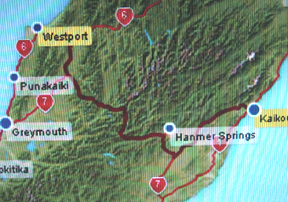 The drive to
Westport, on the opposite coast from Kaikoura is about 207 miles and takes
nearly 5 hours. The route crosses the mountainous spine of the South
Island, going through the Lewis Pass.
The drive to
Westport, on the opposite coast from Kaikoura is about 207 miles and takes
nearly 5 hours. The route crosses the mountainous spine of the South
Island, going through the Lewis Pass.
It might be fun to break the trip up, with a stop in Lewis Pass for a dip in
the hot
spring pools there.
Westport, however, is a primary
designation for this trip, owing to its status as a sister town of our own
Westport, Mass, and the fact that it is off the beaten tourism track in the
South Island. Westport has about a third of the population of our own
Westport (~6,000 vs ~15,000), and sits at the mouth of the Buller River, one of
the largest of the west coast rivers draining to the Tasman Sea.
Historically, Westport gained a foothold as a Gold Rush city in the 1860s, and
then morphed into a coal mining center--particularly involved as a port from
which the region's coal was (and is) shipped.
Tuesday 27 Kaikoura Westport
Self drive to Westport
Accommodation: Westport Motor Lodge
207 Palmerston Street
Westport
Telephone : 64 3 789
7889
Fax : 64 3
789 7885
Wednesday 28 At Westport
A dominant feature of the town is its location near the mouth of the Buller
River. Today the Buller River is the site of interesting
white water rafting
trips. And I've booked a trip with Buller Adventure Tours. The river is
named after Sir Walter Lawry Buller (1838 -1906), who was New Zealand's most
prominent ornithologist. Buller led an interesting, and somewhat suspect
life. His
biographical sketch is worth reading.
Days 7 & 8 Westport to Lake Moeraki
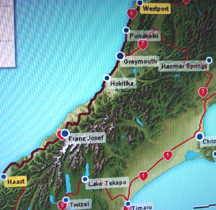 The longest drive
of the trip, I drove down the west coast, through the town of Franz
Joseph, which is a jumping off point for visits to the glaciers in these
mountains. The trip will cover about 390 km, and take 5 1/2 hours.
If I can leave early enough from Westport, I hope to stop near Franz Joseph for
a glimpse of the glaciers, particularly the larger, less frequently visited
Fox Glacier.
The longest drive
of the trip, I drove down the west coast, through the town of Franz
Joseph, which is a jumping off point for visits to the glaciers in these
mountains. The trip will cover about 390 km, and take 5 1/2 hours.
If I can leave early enough from Westport, I hope to stop near Franz Joseph for
a glimpse of the glaciers, particularly the larger, less frequently visited
Fox Glacier.
But the real attraction is Lake Moeraki, which lies in a temperate rain
forest near the coast, about 20 miles north of the town of Haast.
Thursday March, 01 Westport Lake Moeraki
Self drive to Lake Moeraki
Accommodation: Wilderness Lodge Lake Moeraki
State Highway 6 ( 30kms North
of Haast )
Westland
Telephone : 64 3 750
0881
Fax : 64 3
750 0882
Single : Rainforest Lodge Room
2 nights : Dinner bed and
breakfast
Dinner at the lodge
Friday 02 At Lake Moeraki
Breakfast and Dinner at the
lodge
Day at leisure join in eco
tours
In my two days here, I'm looking forward to the hiking tours, emphasizing
bird watching and trips to coast. I may also get a chance to do some trout
fishing. The setting seems ideal, and this is one stop where I don't have
to worry about meals! I'll be sure to file a detailed report on this!
Report:
Drive from Westport to Lake Moeraki. Click
HERE
At Lake Moeraki, Day 9 Click HERE
Days 9 & 10. Lake Moeraki to Queenstown
Being nestled among mountains amid lots of lakes,
Queenstown will be my first (and
only stop) away from the coast line. Due to its scenic splendors, this
region has built quite a reputation as a tourist mecca, and a place for all
sorts of activities.
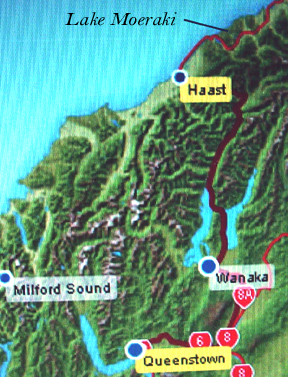 The
drive here from Lake Moeraki will be a scenic 180 miles, taking about four hours.
I'll hope to stop at any interesting looking spot on the way. The two
nights that I stay here will give me some time to explore the varied
opportunities that present themselves!
The
drive here from Lake Moeraki will be a scenic 180 miles, taking about four hours.
I'll hope to stop at any interesting looking spot on the way. The two
nights that I stay here will give me some time to explore the varied
opportunities that present themselves!
Saturday
03 Lake Moeraki Queenstown
Breakfast at the lodge
Self drive to
Queenstown 290kms direct
Accommodation:
Mercure Resort Queenstown
Sainsbury Road, Fernhill
Queenstown
Telephone : 64 3 442
6600
Fax : 64 3
442 7354
2 nights : Room Only
To see the account of the drive to Queenstown, click
Here
Sunday 04 At Queenstown
With a full day ahead
in the Queenstown region, with nothing planned in particular, I decided to look
into the possibilities of doing some trout fishing--a sport that New Zealand is
famous for. Luckily I was able to book a full day of fishing with a
respected guide, Harvey Maguire, who is quite a musician and has worked in
fishery biology in Otago for a number of years. Harvey has a great little
website, that is worth looking at.
Turn up the volume on your computer, so you can hear his piano!
To see the account of trout fishing in Queenstown, click
Here
Day 11 - Queenstown to Doubtful Sound.
This leg of the trip is a fairly short drive (110 miles - 2 1/2 hours) from
Queenstown to Manapouri (not far from Te Anau), where I'm to depart
on a Doubtful Sound
overnight cruise excursion at noon. This will involve a cruise across
Lake Manapouri, then a bus "portage" into the fjord region of southwest New
Zealand for an overnight cruise through the Doubtful Sound system.
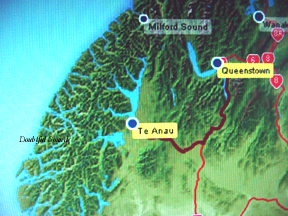 Monday 05 Queenstown Doubtful Sound
Monday 05 Queenstown Doubtful Sound
Self drive to Manapouri
180kms direct
12:10 check in closes
12:30 Doubtful Sound Overnight cruise
excursion departs Pearl Harbour
launch cruise acre Lake
Manapouri
motorcoach travel across Wilmott
Pass
Embark Fiordland Navigator
Accommodation: Remote Location
Fiordland Navigator
Quad Share Cabin
1 night , Dinner bed and
breakfast
Buffet Dinner on board
http://www.realjourneys.co.nz
This should be a fun trip, with lots of scenic beauty, wildlife to see,
kayaking, etc. I'm looking forward to it.
Days 12 - 15 Doubtful Sound to Stewart
Island
Another much anticipated feature of my trip will be three days spent on
Stewart Island, off the
southernmost tip of the South Island. The "third island" of New Zealand,
its location and relative remoteness has allowed more native flora and fauna to
survive here than just about any other place on mainland New Zealand. Much
of my stay will be focused on seeing the birds and ocean life of this
place--which can be touched by more southern fauna from the Antarctic region.
The trip from Manapouri to Invercargill will be about 100 miles, taking 2
1/2 hours. Invercargill is the jumping off place for a short flight across
Foveaux Strait to the Halfmoon Bay region of Stewart Island. I'll leave my
rental car at the airport. If I'm early enough and have some time to spare
before boarding the flight, I hope to drive to the coast to the town of Bluff.
Bluff is famous for its oysters,
having an unique edible oyster, Tiostrea lutarea, favored by epicures
throughout New Zealand..
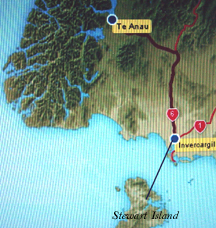 Tuesday
06 Doubtful Sound Stewart Island
Tuesday
06 Doubtful Sound Stewart Island
Breakfast on board
Retrace journey back to
Manapouri
12:30 Excursion ends in Manapouri
Self drive to Invercargil Airport 150kms direct
16:30 Check in closes
17:00 Stewart Island Flights flight
departs
17:20 Arrive Stewart Island Airstrip
Met by lodge host and
transfer to accommodation
Accommodation: Stewart Island Lodge
14 Nichol Road
Halfmoon Bay
Telephone : 64 3 219
1085
Fax : 64 3
219 1085
3 nights : Dinner bed and
breakfast
Dinner at the lodge
20:30 Approx ( 30 mins before dark ) Pick
up by local guide
Ruggedy Range - Eco Watch bird
spotting guided walk
Wednesday 07 At Stewart Island
Breakfast at the lodge
Make own way to Golden Bay Wharf
08:20 Day excursion to Ulva Island
Includes Guide, water taxi
transfers and packed lunch
16:30 Approx return to the wharf
Thursday
08 At Stewart Island
Breakfast and dinner at the lodge
Day at leisure Optional extra
local Half Moon Bay optional sightseeing
I'm excited about some of the planned trips, including a crepuscular trip
for spotting Kiwis and other birds, and the excursion to
Ulva Island
provide opportunities to see birds and plant life hard to find elsewhere.
All told, the time on Stewart Island should all me plenty of opportunities for
hiking and bird watching. This may be one spot on the trip where internet
access is limited, so my reports may be delayed until getting back to the South
Island.
Days 16 - 17. Stewart Island to Dunedin.
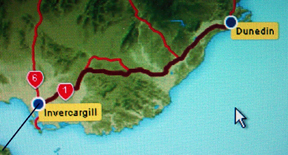 Friday 09 Stewart Island Dunedin
Friday 09 Stewart Island Dunedin
Breakfast at the lodge
Host transfer to Stewart
Island
Airstrip
08:30 Stewart Island Flights
flight
departs
08:50 Arrive Invercargill
Self drive to
Dunedin
220kms direct or
260kms
via Catlins ( note sections of road unsealed )
After flying from Stewart Island back to Invercargill on Friday morning,
I'll reclaim my rental car and take the three hour (130 mile) drive to Dunedin.
Rather than taking the well traveled Rte 1 to Dunedin, I'm planning to take the
route along the coast through an area rich in natural history, known as
the Catlins.
Here I'll probably find lots of birds and marine mammals, as well as great
scenery. In particular I'm looking forward to seeing Curio Bay. This
is known for the remains of a fossilized Jurassic tree fern forest that can be
seen at low tide. On this day low tide is forecast for about noon.
So I should just about hit it right..
Dunedin is one of the older cities
in New Zealand, and with a population today of about 115,000 people, is the
fourth or fifth largest New Zealand city. The city and was originally
populated by Scots is reputed to have a Scottish "feel" to it, and is home to
Otago University.
The city sits at the base of the Otago Peninsula that juts out into the South
Pacific and plays host to a wonderful assemblage of birds and marine mammals.
Accommodation:
Mercure Hotel Dunedin
310 Princes Street
Dunedin
Telephone : 64 3 477
1145
Fax : 64 3
477 1118
2 nights : Room Only
After checking the city out on the day of my arrival, I'll look forward to
Saturday, and participating in planned tours to the
Otago Peninsula to see the Royal
Albatross and Penguin colonies there. Just as New Zealand is unique for
the ability to see Sperm Whales close to shore, it also is the only place in the world
where breeding albatrosses are accessible. Having read and studied about
albatrosses and other large petrels for my Antarctic book, I'm excited about
this part of the trip.
Saturday
10 At Dunedin
09:00 Pick up by Monarch Wildlife Tours
Otago Peninsula Day Tour # 3M
incls
Minivan transfers, guide
Visits to Marine Studies Centre
Royal Albatross Colony
Penguin Place
1 Hour Wildlife cruise on MV
Monarch from Wellers Rock
Optional return to Dunedin by
road or on board MV Monarch
19:00 Approx drop off
After a full day on the tour, I'm sure that I'll have lots to report here.
Days 18 - 19. Dunedin to Christchurch.
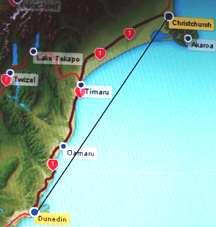 Today I'll have
most of the time free, until the late afternoon when I move on to Christchurch.
So there should be plenty of time to drive about the area, taking in the local
attractions and scenery. Because the journey to Christchurch is a fairly
lengthy one (230 miles, 5 1/2 hours by car), I'm scheduled to turn in the rental
car, and fly to Christchurch
Today I'll have
most of the time free, until the late afternoon when I move on to Christchurch.
So there should be plenty of time to drive about the area, taking in the local
attractions and scenery. Because the journey to Christchurch is a fairly
lengthy one (230 miles, 5 1/2 hours by car), I'm scheduled to turn in the rental
car, and fly to Christchurch
Sunday
11 Dunedin Christchurch
Self drive to Dunedin
Airport 45kms direct
16:00 Drop off rental car at the airport
NZ5368T 11MAR DUD CHC 455P 550P * 16:55
Flight NZ5368 departs
17:50 Arrive Christchurch 5:50 P
TRANSFER OWN ARRANGEMENTS to hotel
Accommodation: Copthorne Central Christchurch
776 Colombo Street
Christchurch
Telephone : 64 3 379
5880
Fax : 64 3
365 4806
2 nights : Room Only
Monday
12 At Christchurch-
Day own arrangements
Just as Dunedin sits at the base of the Otago Peninsula, the city of
Christchurch is positioned at the base of another peninsula, the Banks
Peninsula, that projects into the South Pacific. Christchurch is the South
Island's largest city, with a population of about 350,000. The city has a
number of science-related features that interest me.
Canterbury University, originally located in the city (it has moved to the
suburbs) was the alma mater of the Nobel Prize winner,
Ernest Rutherford. Rutherford, later in life, was director of the
Cavendish Laboratory at Cambridge (England) University when my father was a
doctoral student there. I hope to visit the site ("Rutherford's Den")
where Rutherford conducted his early experiments.
Christchurch also has many ties to early Antarctic Exploration, and even
today is the supply base for airlifting materials to the U.S. Antarctic bases at
Palmer Island and McMurdo Sound. I plan on spending some of my day in
Christchurch visiting the Canterbury Museum, with its "Hall of Antarctic
Discovery", as well as a famous display of material relating to the extinct Moas.
And I'll also plan to walk through the center of the city, taking in its
abundant sights. I'll report what I find here.
Tuesday 13 Depart
Christchurch
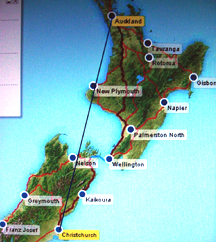 Today will be the
longest day of my life! I'm scheduled to fly home. First, I'll fly
from Christchurch to Auckland. This first leg of the trip home should take
me right over the Canterbury plains, where shallow braided river systems drain
the glacier-rich Southern Alps to the west. My sister, Ann, tells me that
geologists see this area as a modern example of how our own Great Plains formed
from similar rivers draining eastward from the Rocky Mountains. Then in Auckland
I get right onto the plane to Los Angeles.
Then from LA to Charlotte, NC, and finally from Charlotte to Providence.
The schedule has me leaving Christchurch at 2:50 pm local time, and arriving in
Providence about 11:30 pm local time, still on March 13. But the total
time, including layovers, is about 29 hours! It will be a long day!
Today will be the
longest day of my life! I'm scheduled to fly home. First, I'll fly
from Christchurch to Auckland. This first leg of the trip home should take
me right over the Canterbury plains, where shallow braided river systems drain
the glacier-rich Southern Alps to the west. My sister, Ann, tells me that
geologists see this area as a modern example of how our own Great Plains formed
from similar rivers draining eastward from the Rocky Mountains. Then in Auckland
I get right onto the plane to Los Angeles.
Then from LA to Charlotte, NC, and finally from Charlotte to Providence.
The schedule has me leaving Christchurch at 2:50 pm local time, and arriving in
Providence about 11:30 pm local time, still on March 13. But the total
time, including layovers, is about 29 hours! It will be a long day!
2:50PM QF4132V departs Christchurch
4:10PM Arrives Auckland
6:40PM
QF 25V Departs Auckland
10:30AM Arrives Los Angeles
1:00 PM US Airways #1496 from LAX to Charlotte
8:31 PM Arrive Charlotte
9:45 PM US Airways #1142 to Providence
11:38 PM Arrives Providence!!!!
END OF TRIP
 Altogether the country is
about the size of Colorado in terms of land area, and is host to about 4 million
inhabitants. It sits in the South Pacific Ocean, with the Tasman Sea to
its west. The North Island rubs against the 180th meridian, and in terms
of latitude it stretches from about 35 degrees South, to about below 45 degrees South.
New Zealand is astride the junction of two tectonic plates, and earthquakes and
volcanic activity are not uncommon. The North Island, in particular, is
host to geothermal regions with hot springs and geysers regular features.
The New Jersey-shaped South Island has been more orogenic and sports a
cordillera on its western side, with fairly broad outwash plains on the east.
The southwest corner (Southland) of the South Island is broken into a
spectacular set of fjords.
Altogether the country is
about the size of Colorado in terms of land area, and is host to about 4 million
inhabitants. It sits in the South Pacific Ocean, with the Tasman Sea to
its west. The North Island rubs against the 180th meridian, and in terms
of latitude it stretches from about 35 degrees South, to about below 45 degrees South.
New Zealand is astride the junction of two tectonic plates, and earthquakes and
volcanic activity are not uncommon. The North Island, in particular, is
host to geothermal regions with hot springs and geysers regular features.
The New Jersey-shaped South Island has been more orogenic and sports a
cordillera on its western side, with fairly broad outwash plains on the east.
The southwest corner (Southland) of the South Island is broken into a
spectacular set of fjords.
 Auckland, New Zealand's largest city is reputed to be a vibrant, interesting
place (http://www.aucklandnz.com/ ).
Its urban region includes 1.2 million people (more than 25% of the total
population of New Zealand) spread out over more than 400 square miles. The
main city area is located on an isthmus with close access to water on both
sides. The opportunity for water sports is great, and Auckland is
sometimes called, "The City of Sails." (http://en.wikipedia.org/wiki/Auckland).
Auckland, New Zealand's largest city is reputed to be a vibrant, interesting
place (http://www.aucklandnz.com/ ).
Its urban region includes 1.2 million people (more than 25% of the total
population of New Zealand) spread out over more than 400 square miles. The
main city area is located on an isthmus with close access to water on both
sides. The opportunity for water sports is great, and Auckland is
sometimes called, "The City of Sails." (http://en.wikipedia.org/wiki/Auckland).
 My
first impressions of Auckland were that it has a pretty vibrant center city
section. The streets are flooded with people, cars and buses. Lots
of pretty young girls, a just about everyone, sans the tourists, are well
dressed. My hotel is right on the main drag (Queen St), a few blocks above the
harbor. Right across the street is the old City Hall, that doubles as a
concert hall for the Auckland Chorus, among other performing groups.
My
first impressions of Auckland were that it has a pretty vibrant center city
section. The streets are flooded with people, cars and buses. Lots
of pretty young girls, a just about everyone, sans the tourists, are well
dressed. My hotel is right on the main drag (Queen St), a few blocks above the
harbor. Right across the street is the old City Hall, that doubles as a
concert hall for the Auckland Chorus, among other performing groups. 

 The signature Sky
Tower of the town is just two or three blocks away. The waterfront is
active with local cruise boats, ocean-going cruise liners, and lots of people
milling around. There are many restaurants, here, and I had a nice lunch
in a fairly elegant Japanese one, with some sashimi and grilled eel over rice.
It was good.
The signature Sky
Tower of the town is just two or three blocks away. The waterfront is
active with local cruise boats, ocean-going cruise liners, and lots of people
milling around. There are many restaurants, here, and I had a nice lunch
in a fairly elegant Japanese one, with some sashimi and grilled eel over rice.
It was good.
 With
a little time to kill, I made a quick trip through the Auckland Maritime Museum.
It was interesting--especially the material and information about Maori war
canoes, Captain Cook's visits to New Zealand, and some of the information they
had about the whaling days. They had a very nice film of the actual
killing of a right whale from shore based boats, using exploding harpoons.
It was interesting.
With
a little time to kill, I made a quick trip through the Auckland Maritime Museum.
It was interesting--especially the material and information about Maori war
canoes, Captain Cook's visits to New Zealand, and some of the information they
had about the whaling days. They had a very nice film of the actual
killing of a right whale from shore based boats, using exploding harpoons.
It was interesting.
 Accommodation: The Rutherford A Heritage Hotel
Accommodation: The Rutherford A Heritage Hotel




 After
nursing the car along the "wrong" side of the road into the town of Nelson, I
found my hotel--The Rutherford--in the city center. It was easy to find,
as at about 9 stories high, it is clearly the tallest building in town.
After
nursing the car along the "wrong" side of the road into the town of Nelson, I
found my hotel--The Rutherford--in the city center. It was easy to find,
as at about 9 stories high, it is clearly the tallest building in town.





 Accommodation: Kaikoura Gateway Motor Lodge
Accommodation: Kaikoura Gateway Motor Lodge The drive to
Westport, on the opposite coast from Kaikoura is about 207 miles and takes
nearly 5 hours. The route crosses the mountainous spine of the South
Island, going through the Lewis Pass.
The drive to
Westport, on the opposite coast from Kaikoura is about 207 miles and takes
nearly 5 hours. The route crosses the mountainous spine of the South
Island, going through the Lewis Pass. The longest drive
of the trip, I drove down the west coast, through the town of Franz
Joseph, which is a jumping off point for visits to the glaciers in these
mountains. The trip will cover about 390 km, and take 5 1/2 hours.
If I can leave early enough from Westport, I hope to stop near Franz Joseph for
a glimpse of the glaciers, particularly the larger, less frequently visited
Fox Glacier.
The longest drive
of the trip, I drove down the west coast, through the town of Franz
Joseph, which is a jumping off point for visits to the glaciers in these
mountains. The trip will cover about 390 km, and take 5 1/2 hours.
If I can leave early enough from Westport, I hope to stop near Franz Joseph for
a glimpse of the glaciers, particularly the larger, less frequently visited
Fox Glacier.  The
drive here from Lake Moeraki will be a scenic 180 miles, taking about four hours.
I'll hope to stop at any interesting looking spot on the way. The two
nights that I stay here will give me some time to explore the varied
opportunities that present themselves!
The
drive here from Lake Moeraki will be a scenic 180 miles, taking about four hours.
I'll hope to stop at any interesting looking spot on the way. The two
nights that I stay here will give me some time to explore the varied
opportunities that present themselves! Monday 05 Queenstown Doubtful Sound
Monday 05 Queenstown Doubtful Sound Tuesday
06 Doubtful Sound Stewart Island
Tuesday
06 Doubtful Sound Stewart Island Friday 09 Stewart Island Dunedin
Friday 09 Stewart Island Dunedin  Today I'll have
most of the time free, until the late afternoon when I move on to Christchurch.
So there should be plenty of time to drive about the area, taking in the local
attractions and scenery. Because the journey to Christchurch is a fairly
lengthy one (230 miles, 5 1/2 hours by car), I'm scheduled to turn in the rental
car, and fly to Christchurch
Today I'll have
most of the time free, until the late afternoon when I move on to Christchurch.
So there should be plenty of time to drive about the area, taking in the local
attractions and scenery. Because the journey to Christchurch is a fairly
lengthy one (230 miles, 5 1/2 hours by car), I'm scheduled to turn in the rental
car, and fly to Christchurch Today will be the
longest day of my life! I'm scheduled to fly home. First, I'll fly
from Christchurch to Auckland. This first leg of the trip home should take
me right over the Canterbury plains, where shallow braided river systems drain
the glacier-rich Southern Alps to the west. My sister, Ann, tells me that
geologists see this area as a modern example of how our own Great Plains formed
from similar rivers draining eastward from the Rocky Mountains. Then in Auckland
I get right onto the plane to Los Angeles.
Then from LA to Charlotte, NC, and finally from Charlotte to Providence.
The schedule has me leaving Christchurch at 2:50 pm local time, and arriving in
Providence about 11:30 pm local time, still on March 13. But the total
time, including layovers, is about 29 hours! It will be a long day!
Today will be the
longest day of my life! I'm scheduled to fly home. First, I'll fly
from Christchurch to Auckland. This first leg of the trip home should take
me right over the Canterbury plains, where shallow braided river systems drain
the glacier-rich Southern Alps to the west. My sister, Ann, tells me that
geologists see this area as a modern example of how our own Great Plains formed
from similar rivers draining eastward from the Rocky Mountains. Then in Auckland
I get right onto the plane to Los Angeles.
Then from LA to Charlotte, NC, and finally from Charlotte to Providence.
The schedule has me leaving Christchurch at 2:50 pm local time, and arriving in
Providence about 11:30 pm local time, still on March 13. But the total
time, including layovers, is about 29 hours! It will be a long day!